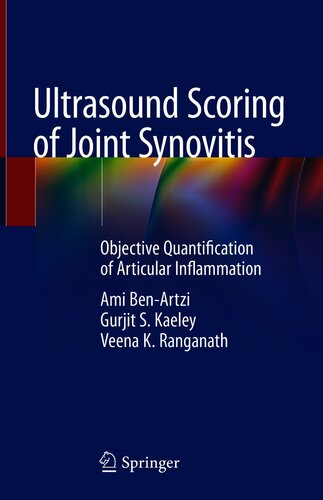ثبت سونوگرافی سینوویت: کمی سازی عینی آرتریت ۲۰۲۱
Ultrasound Scoring of Joint Synovitis: Objective Quantification of Articular Inflammation 2021
دانلود کتاب ثبت سونوگرافی سینوویت: کمی سازی عینی آرتریت ۲۰۲۱ (Ultrasound Scoring of Joint Synovitis: Objective Quantification of Articular Inflammation 2021) با لینک مستقیم و فرمت pdf (پی دی اف)
| نویسنده |
Ami Ben-Artzi, Gurjit S. Kaeley, Veena K. Ranganath |
|---|
| تعداد صفحهها |
213 |
|---|---|
| نوع فایل |
epub |
| حجم |
146 Mb |
| سال انتشار |
2021 |
89,000 تومان
معرفی کتاب ثبت سونوگرافی سینوویت: کمی سازی عینی آرتریت ۲۰۲۱
آرتریت تظاهرات رایج بسیاری از بیماری های خود ایمنی است. نمره آرتریت اغلب به عنوان معیاری برای فعالیت بیماری استفاده می شود. ارزیابی فعالیت بیماری دارای پیامدهای تشخیصی، درمانی و پیش آگهی است. آرتریت اغلب به عنوان شاخص التهاب در سایر بافت ها استفاده می شود و ارزیابی این التهاب پیامدهایی برای سلامت بسیاری از اندام های بدن دارد. پزشکان در حال حاضر از لمس مفصل برای ارزیابی آرتریت استفاده می کنند. این روش در حالی که به راحتی قابل دسترسی و کاربردی است، فاقد دقت است. بیش از 20 سال است که از سونوگرافی برای ارزیابی آرتریت استفاده می شود، اما استفاده از فناوری اولتراسوند چالش برانگیز است. در مورد دید بهینه مفصل، اینکه کدام مفاصل در کدام بیماری باید بررسی شوند و التهاب چگونه باید طبقه بندی شوند، اختلاف نظر وجود دارد. پروتکل های اسکن و طرح های طبقه بندی مختلفی پیشنهاد شده است، اما هر کدام نقاط قوت و ضعف خاص خود را دارند.
ارزیابی اولتراسوند آرتریت سینوویال بر اساس کار سه نویسنده است که به محدودیت های سیستم های امتیازدهی التهاب معاصر پرداخته اند و یک سیستم امتیازدهی التهاب مبتنی بر اولتراسوند را ایجاد کرده اند که می توان از آن استفاده کرد. با استفاده از سازگاری و تکرارپذیری در مقاله خود، نویسندگان هزاران مفصل را اسکن کردند و هزاران ساعت را صرف بحث در مورد اسکن کردند. آنها یک سیستم امتیازدهی تولید کرده اند که به کاربر اطلس اجازه می دهد تا آرتریت را به گونه ای طبقه بندی کند که کمتر ذهنی و قابل تکرارتر از سیستم های فعلی در حال استفاده است. توصیفات عینی به کاربر اجازه می دهد تا نشانگرهای اولتراسوند آرتریت را با سوگیری عمدی نسبت به مرتبط ترین ویژگی های بالینی آسیب شناسی اولتراسوند شناسایی کند. برای دانشجویان سونوگرافی اسکلتی عضلانی، این کتاب شرح مفصلی از ظاهر اولتراسوند برای هر سطح از آرتریت ارائه می دهد. برای محققان، کتاب و سیستم ارائه شده در کتاب واقعاً پیشرفته است و امکان دقت بهتر در تحقیقات و مراقبت های بالینی بیماران مبتلا به آرتریت را فراهم می کند.
A common manifestation of many autoimmune diseases is joint inflammation. The degree of inflammation of the joints is often used as a metric of disease activity. Assessing disease activity has diagnostic, therapeutic, and prognostic implications. Inflammation of the joints is often used as a proxy for inflammation in other tissue, and assessing this inflammation has implications for the health of numerous organs in in the body. Currently, physicians use palpation of joints to assess for joint inflammation. This method, while accessible and easy to apply, is lacking in precision. Ultrasound has also been used to assess for joint inflammation for over 20 years, but applying ultrasound technology has proved challenging. There is lack of agreement on optimal joint view, which joints should be examined in which disease, and how inflammation should be graded. Various scanning protocols and grading schemes have been proposed, but each has its strengths and weaknesses.
Ultrasound Scoring of Joint Synovitis is based off the work of three authors who tackled the limitations of contemporary inflammation scoring systems, and developed an ultrasound-based inflammation scoring system which can be applied with consistency and reproducibility. In their research, the authors scanned thousands of joints and spent thousands of hours discussing the scans. They produced a scoring system which will allow the user of the atlas to grade joint inflammation in a way that is less subjective and more reproducible than the current systems used. Objective descriptions allow the user to quantify sonographic signs of joint inflammation with an intentional bias for the more clinically relevant features of ultrasound pathology. For students of musculoskeletal ultrasound, the book offers detailed descriptions of the sonographic appearance of every level of joint inflammation. For researchers, the book, and the system laid out in the book, are truly state-of-the-art and will enable better precision in research and clinical care of patients with joint inflammation.



